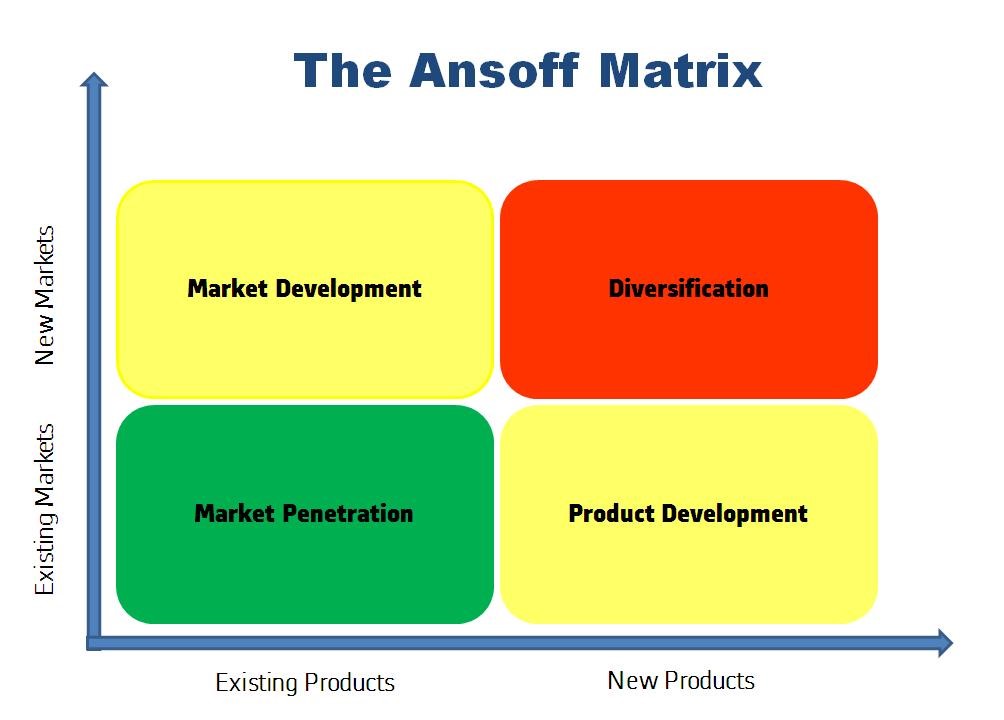Is your business’s growth curve flattening? Is your revenue growing but bringing up costs with it? Do you need to expand but don’t know how exactly to go about it? The Ansoff Matrix is the answer to your expansion problems!
It guides you along the best path to expansion according to your business’s needs. Should you further sharpen your product or sail searching for a new market? Should you solidify your hold on the same market or diversify into a new segment?
The Ansoff Matrix is like an oracle for business development. It won’t tell you what to do, but can tell you where the danger lies. It can tell you the consequences of a particular kind of development.
Projections suggest that the B2B market will grow at an annual rate of 12.9% up to 2028. From 2022 to 2023 B2B market grew by 18%!
If you want a share of this growth bounty, you must steer your business in the right direction. The Ansoff Matrix is the compass that will help you do so.
Let’s understand how Ansoff can guide your business toward the bright light of growth.
What is the Ansoff Matrix?
Named after a legendary Russian-American businessman, the Ansoff Matrix is a famous formula for business development. It imagines the product along the X-axis of a graph and the market along the Y-axis. There are two considerations along each axis:
- Product development and diversification along the product axis.
- Market Development and Market Penetration along the Market Axis.
The Ansoff Matrix is built on two units of every business – the product and the market. It combines insights about both to generate four different growth strategies businesses can apply.
The Ansoff Matrix understands three key principles of B2B enterprises:
- B2B companies are like sharks. If they are to survive, they need to keep moving. If they don’t grow, they’ll drown.
- The next great enterprise won’t invent a social network like Facebook. Nor will it perfect organizational communication like Slack. It’ll create something entirely new.
- Growth is as much a product of the business as the business is a product of growth. The business and its growth are in a circular relationship.

The Ansoff Matrix recognizes the instinct for growth and the tendency for decay within business processes. It can see when a business cycle is ending, so it can predict and point to the beginning of a new one.
The matrix understands the market and its products through the three principles of B2B enterprises. It thus shows us the four ways of business expansion:
- Product Development: create new missions through new products.
- Market Development: finding new markets for existing products.
- Market Penetration: offering existing products to existing markets.
- Diversification: expanding into new markets through entirely new products.
Depending on your business’s history and needs, you can choose an optimal growth strategy. Let’s examine why your company might need to deploy the Ansoff Matrix.
Why Use the Ansoff Matrix?
We have seen that expansion is vital for a business, especially for B2B enterprises. Without it, bottom lines will decline, and growth curves will flatten. But, there could be several ways of achieving growth.
So why exactly should you use an Ansoff Matrix? There are four main reasons:
1. Harness Advances in Technology
Cutting costs is a way of keeping the bottom line up. Nothing cuts more costs than technological breakthroughs that shatter the old ways. They show new paths that reduce operational costs, sharpen supply chains and increase capacity.
But why must you expand to harness the power of technology? Isn’t efficiency itself desirable? That’s a good question. But a better question is, why should you value efficiency if not as a tool for expansion?
Efficiency through technological advancement is definitely desirable. This efficiency will free up resources and reduce the time needed to complete existing operations. Time saved is both money and a resource. You can channel this into expanding further.
- Slack can save several minutes a day from sluggish internal communication,
- Machine Learning can reduce delivery times by several hours with predictive powers,
- Visual generation can help understand data through images and graphs,
The seconds, minutes and hours saved translate directly into weeks of business operations. Here, then, is the indirect link between technology on the one hand and expansion on the other. With better technology, you can:
- Develop more markets,
- Think of new products,
- Penetrate existing market segments.
Conversely, to expand, you will be forced to:
- Sharpen supply chains,
- Narrow communication channels,
- Incorporate analytics.
Thus, expansion requires adopting new technologies, and new technologies drive expansion. The Ansoff Matrix tells you how to expand in a way that best suits your business.

2. Channel Excess Capacity
Large corporations are buying back their shares at a rate never seen before. These corporations don’t want the market to take advantage of its growth. Rather, they want to drive reinvestment into business processes.
These enterprises know that without growth, dividends will continue to decrease. So, they channel a huge portion of their earnings into business expansion.
Various factors play a part in increasing dividends, revenue and growth. They can be external factors that generate windfall gains or internal practices that bring about steady gains.
However, in the absence of reinvestment, all three indicators will slump, usually in coordination.
Expansion via the Ansoff Matrix helps you understand your revenue, growth and profitability.
It tells you where you’re strong:
- Have you captured a market no one has tapped into?
- Does your product have a unique competitive advantage?
- Has the market situation worked in your favor?
- Is there a particular feature in your business model that favors customer retention?
- Are your operations particularly lean and free up capacity?
An Ansoff analysis thus tells you two things. The first is the reason for excess capacity or profitability. The second is the best way of channeling this capacity into growth and security. An Ansoff Matrix is an insurance policy on future profitability.
3. The Ansoff Matrix Drive Compatible Growth
Enterprises often understand the need for growth. They know they must move forward or face a general decline. However, they don’t know the roadmap to success. They are often stuck in a rut. Sometimes, they are fascinated by specific market trends that capture their attention.
The Ansoff Matrix cuts through this noise. It asks businesses pinpoint questions that help whittle down instincts into offerings. It doesn’t merely ask, “Where is the biggest profit?” It also questions your business’s ability to get that profit.
It forces a business to evaluate its past to lay out a coherent future. An Ansoff Matrix will help you ask yourself:
- Where is the gap between the competition’s strength and your weakness?
- What market have you left untapped? Why?
- Which market can you most effectively capture with the current offering?
- To what extent can you manipulate your product for different market segments?
- Do you have or can you envision a path to marketing and distributing your product to new markets?
The Ansoff Matrix can tell you which direction to take to achieve maximum growth by asking questions about your business.

4. Sharpen Business Operations
Growth and profitability are not just a consequence of a great product. One of five products fails right after its launch. Surely, not all of them are bad solutions to the problems they wanted to solve. Most are either misunderstood or more suited to solve other problems.
Thus, business processes are as important as product ideas. Arguably, product ideas are themselves outcomes of business processes. And a well-run business will have smooth processes, just like a well-oiled machine.
An Ansoff Matrix-driven expansion can be the impetus to move this well-oiled machine forward. Alternatively, it can also be the oil that wells your business machine.
Once your company has achieved the market share you desired, it is bound to slump into oblivion. Unless, of course, you utilize the peak to chart out a new course of action. Ansoff Matrix is the compass that will help you survey the marketplace for this new course.
Expansion unlocks healthier business operations and greater profitability. The Ansoff Matrix can be a great catalyst. Let’s see what it tells us about expansion strategies based on developing products and markets.
The First Play – Product Development
According to Ansoff, every product has a “mission.” The mission of an aircraft is to transfer you from one place to another. The mission of a petrol pump is to fuel your journeys.
Product development refers to the process of devising new solutions for new missions. Let’s assume your company has created a pen for writing and recording. Product development is when you develop an eraser to enable users to correct errors arising from using the pen. You have created a necessity that you can then solve. The missions are complementary – one depending on and arising out of the other.
B2B and SaaS product development can take several forms. It is a complex process that requires different steps. It includes surveying the market, prototyping, commercialization and more.

Let us look at some ways in which the industry engages in product development:
1. The BAH Model
Booz, Allen and Hamilton Model, popularly known as the BAH Model, was introduced by the three namesake business strategists in 1982. It requires seven steps:
- New product strategy,
- Idea generation,
- Screening and evaluation,
- Business Analysis,
- Development,
- Testing,
- Commercialization.
The BAH Model guides product development from its gestation right to market maturity and delivery. Although introduced more than thirty years ago, it still serves as a model for New Product Development (NPD) processes.
2. ExPD – Exploratory Product Development
Consultants Mary Drotar and Kathy Morrissey developed the ExPD model in 2015. They aimed to adapt NPD processes to the contemporary world. Their chief considerations were risk aversion against:
- A changing, unpredictable market,
- A globalized world,
- Governmental regulation,
- Fast-moving technology.
Their strategy speaks to a modern business landscape. It takes into account:
- Business strategies and organizational frameworks,
- Metrics against which success is judged, and
- Customer understanding and business processes.
Drotar and Morrissey have written two books fleshing out their product development idea.
3. IDEO Approach
IDEO is a designing and consulting firm that has developed one of the most well-researched product development ideas thus far. Its process involves the following steps:
- Understand and observe the following: The market, the client, the technology, and the Limitations of the problem.
- Create a synthesis of the information collected during step one,
- Visualize the new users who will utilize the product,
- Prototype the product, then evaluate and improve it,
- Implement design changes.
The last step is necessary for technologically advanced processes and requires time. However, this is a comprehensive process that both B2B and B2C firms can follow for NPD processes.
4. Lean Startup Approach
The Lean Startup Approach helps develop new products by shortening product development cycles. It is based on rapidly discovering whether a product is viable or not based on customer feedback. It rests on three key features:
- Business hypothesis-driven experimentation,
- Iterative product releases, and
- Validated learnings.
This method prioritizes user feedback over intuition and flexibility over rigorous planning. Lean Startup Approaches enable recovery from failed processes far more than other processes.

5. Stage-Gate Model
We saved the best NPD strategy for last. As of 2010, 88% of American businesses used this approach to develop new products. In return, the companies benefited from improved teamwork and increased success rates. They also discovered earlier failure detection and shorter launch cycles.
Robert G. Cooper developed the Stage-Gate Model in the consumer goods sector. It consists of eight “gates:”
- Preliminary,
- Technical Assessment,
- Source-of-Supply Assessment,
- Market Research (size and segmentation analysis),
- Product Idea Testing,
- Customer Value Assessment,
- Product Definition,
- Business and Financial Analysis.
These eight gates will result in a “Go/No-Go” and Development decisions. Crossing each gate will incrementally tell you whether to further develop a product.
We have seen the five most common product development models currently available. Through these, you can craft a custom way of developing a new product to expand your business. But when should you deploy Product Development techniques?
- You have saturated the market for your current product,
- Customer pain points compel you to develop synergistic offerings,
- The competition is expanding its catalog of products,
- A windfall profit can be invested in R&D,
- The government is offering subsidies to solve urgent and industry-related problems.
However, product development may be expensive. It might not suit your current R&D plans. Or it might be that you have saturated the markets available to your current products. Worry not. For such scenarios, the Ansoff Matrix provides us with other expansion techniques.
The Second Coming – Market Penetration
Market penetration is an expansion strategy suited to young businesses and startups. Its goal is to expand using current offerings in the current market. The aim is to sell current products, services or subscriptions to more customers. Or, the idea is to sell more offerings to already established customers.
Once you have developed a strong product using the processes we learned above, you must ensure that it reaches everybody and delivers its competency through aggressive marketing and distribution channels.
Typically, market penetration involves more focus on selling and marketing strategies. It also involves pushing distribution and aggressively promoting existing products.
The following are some of the most common market penetration tactics:
- Decreasing the price of the product,
- Increasing promotions and sharpening the distribution channels of your product,
- Acquiring a rival/competitor within your segment,
- Refining the product subtly to cater to a wider group of prospects.
Of the four Ansoff Expansion strategies, market penetration is the most risk-averse. It does not go beyond the existing competencies of your business. It relies only on a more aggressive combination of marketing and sales strategies.

Market penetration gives your future products a better chance of success. You can use the robust supply chains you have developed for new products you develop.
Therefore, use market penetration as your expansion strategy when:
- The Competition is Busy with New Products
Refining the same product will give you a competitive edge. It will also help you expose the competition’s weaknesses. It can further help establish trust when bringing your product to new users.
- You Have a Competitive Advantage
Say your product already has a big competitive advantage. It may be a utility that you provide, a pain point with which you empathize or a need you’re fulfilling. You’ll want to press this advantage before your competition can either adapt to it or come up with a response.
- Your Product Development Channels are Closed
Product development can take time and this time can spell the end of your business. You might not even have time to launch the new product! In such a scenario, divert some resources to market penetration. This small investment will keep your business afloat until your new product evolves.
Market Penetration helps you capture bigger segments of your existing market. It helps drive faith in your product, shows users that you trust your competency, and touches upon different pain points.
However, it might be possible that the growth curve is flattening even after doing all of this. In such cases, you may need to turn to market development. Let’s see what it is.
The Third Strike – Market Development
We have seen that market penetration means consolidating gains within an existing market. Market development, on the other hand, means searching for newer and bigger markets.
The Ansoff Compass tells us that there are always bigger, newer maps and territories to be captured. The globalized world and strong exports are driving increased demand for B2B solutions. More than 90% of executives believe remote sales will be a part of the new B2B normal.

B2B enterprises that have thus far remained steadfast on in-person marketing and handshake deals will soon find these tactics outdated. Developing new markets is set to become an important part of the expansion playbook.
How can you develop a new market for your B2B enterprise?
- Change segments to accommodate more customers,
- Cater to unique customer profiles by customizing products and services,
- Reach new territory in domestic markets by copyrighting and trademarking products and ideas,
- Conquer foreign markets by taking advantage of government shakeups and regulatory changes.
Expansion through market development can prove very advantageous when you know your product is competitive. It implies that your product will be able empathize with globalized pain points. Slack is an example here. Every startup and business will have internal communication problems, no matter where the market or business is operating.
Market development should be the go-to expansion strategy in the following circumstances:
- You have a product with a strong or unique competitive advantage,
- The development will increase the economies of scale (especially in production),
- Users in new markets have the same pain points as users in the saturated market,
- There is no additional cost for customer acquisition in the market,
- The infrastructure supports strong distribution channels in the new markets.
Thus, market development is a great opportunity for slow and steady expansion. It helps drive the credibility of your company as a global or an international brand. It also equalizes customer pain points and exposes your product to new missions.
However, sometimes, new markets are out of reach. The pain points are different across continents. Or the acquisition cost is too high. Or, perhaps the local competition is getting governmental subsidies, strengthening its position. Such factors can close off the possibility of market development.
For the Ansoff Matrix, this is a small problem. It has other ways of helping your company expand. Let’s see how.
The Fourth Call – Diversification
Diversification refers to developing a new product for an entirely new market. If your company has reached the diversification stage, it has exhausted all other avenues of expansion. It has also utilized the existing offerings for every competency it could offer.
Diversification is the riskiest expansion strategy. It is unlikely that your company will be able to transfer competencies across different products and markets simultaneously. Instead, it will be forced to develop new ones, which can take time and consume several resources.
Diversification is useful when:
- You have established products for long-term markets,
- Steady revenue streams and clients have nourished existing businesses,
- The rate of profit for existing businesses is flattening,
- All existing and open markets have been saturated,
- Product development is not generating marginal benefits like they used to.
However, diversification means a change in competencies. It also needs a new business plan. It might need several new business plans from which one will succeed. Diversification makes a company into a conglomerate. It can also make a company into a husk of its former self.
Diversification is thus a double-edged sword. It can pierce other products and markets. But it can also bite into your existing businesses. Thus, it can drive down the profitability. Moreover, diversification does not have any set rules. It can depend on related segments but also move in radically different directions.

There are usually two types of diversification:
- Related Diversification
The business diversifies to solve a connected competency. For instance, Slack can diversify into the video calling segment. Through related diversification, a company can:
- Transfer competencies,
- Use similar distribution channels,
- Synergize distribution networks.
Google has entered the travel business after merging Flights into its model. Another instance is a tire company that starts manufacturing breaking equipment.
- Unrelated Diversification
Unrelated diversification is more difficult. It requires a huge initial investment. Transfer of competency is not available to such diversification. The business diversifies in an unrelated direction to take advantage of:
- Passion projects,
- Changing market conditions, and
- Short-term governmental subsidies.
Unrelated diversification is often the call of huge conglomerates. They depend on financial analysis and long-term planning to observe profitable market gaps.
INEOS, an energy company that invests in F1, is an instance of related diversification. However, acquiring soccer teams makes its diversification unrelated.
Diversification makes even the biggest businesses look like pawns on a chessboard. Diversification is possible for small and medium enterprises as well. However, they must make their diversification strategies narrow and precise to achieve the desired results.
How to Utilize the Ansoff Matrix?
The Ansoff Matrix tells us that market penetration is the easiest expansion avenue. This is because the product and the market remain the same; only the tactics change.
A change in the product implies a change in competency. On the other hand, a change in the market implies a change in distribution and marketing methods. Thus, market and product development require lateral movement within the Ansoff Matrix.
According to the matrix, diversification is the toughest expansion strategy. It requires two movements – within the market and the product.
Apart from the considerations of the market and the product, here are some tips to help you optimally use the Ansoff Matrix:
1. Evaluate the Alternatives
As we have seen, market penetration requires only a shift in tactics. Similarly, market and product development require only one degree of lateral movement. Diversification requires a dual movement of product and market, making it the hardest expansion strategy.
Thus, the first tip for you, an executive, is to “evaluate the risk you are willing to take.” If you are seeking a risk-averse strategy, go for market penetration. If you have an opportunity to gamble, opt for diversification. The greater the risk, the greater the potential reward.
2. Analyze Market Conditions
Often the greatest clue for expansion comes from the market conditions. The market winds are the best indicators of where the most profit resides. Government subsidies often tell you how the taxpayer money is being spent.

Some markets are seasonal. Others are annual or multi-decadal. The technology market is, for instance, millennial. It has arrived for the first time in thousands of years. Thus, don’t just evaluate expansion alternatives. Review them in light of how the market behaves.
3. Understand Competitor Behavior
You can tell a lot about the competition from the way it moves. Is it consolidating existing markets? Is it preparing for a period of product development? Is it expending resources into long-term market development?
Knowing how others in your industry move makes your task easier. You can then position your expansion plans to take maximum advantage. You can attack a gap they leave open or match their strategy head-on!
4. Remember Company History
Your company’s history will tell you much about how it can expand optimally. If you have handled expansion exercises before without trouble, you can be more confident of a riskier bet. However, if this is your first expansion move or a previous move has failed, throw caution to the wind.
Moreover, company history can also tell you about your strengths and weaknesses. It can tell you the pain points to which it has successfully empathized. It can also show you where your company has never been. Your past experiences will give you a solid footing or a reason to jump in different directions.
5. Combine with Other Tools
It is never wise to put all your eggs in the same basket, especially when making expansion plans. Utilize other tools, such as SWOT analysis, for your company. Look at the financial condition and statements of your company and expansion proposal. Data analytics will also tell you about the potential strengths and weaknesses of your enterprise after expansion.
Remember that the Ansoff Matrix is only a compass, not the entire guidance system. It is one tool, among others, to help you see more clearly and point more sharply. Your ship must not rely merely on direction but also on the windspeed, the wave strength and the depth of the water for a successful journey.
Conclusion
The Ansoff Matrix presents you with degrees of expansion plans arranged by their risk averseness. You can depend on it to point you in the right direction when looking for where to expand. Its power lies in its simplicity. It operates on the basis of the two things that drive your business – the product and the user (the market.)
When your solution (the product) solves user problems (the market) and gives you its rewards (profits), the Ansoff Matrix tells you how to capitalize on them.
Should you trust the existing market or move to a new one? Should you stick to the current problem or empathize with a new one? Just ask Ansoff, and Lean Summits! Like Ansoff, we act as your compass in the shifting market.
Turbulent conditions threaten to unravel even the most established businesses. Tried methods that have passed the toughest tests become tired and need rest.
We help you diversify and expand by merging what you knew with what is new.
Don’t wait, schedule a free consultation today and sample the winds of market change with us!


